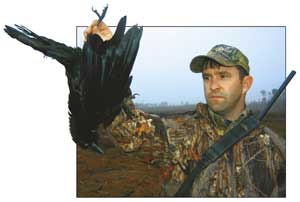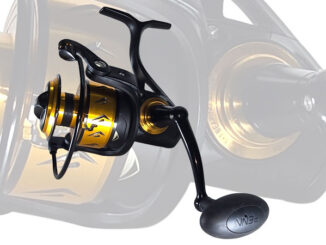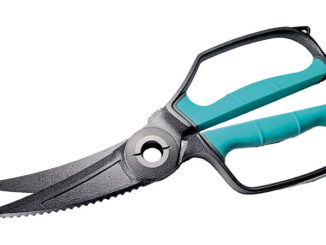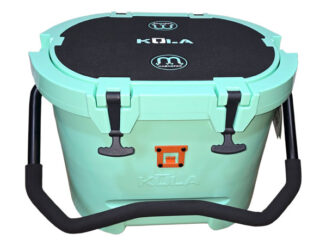
Avid duck hunter Jeremy Poirier doesn’t abandon wingshooting when waterfowl are off-limits.
When it comes to game birds, the wild turkey has no rival. Like nothing else in nature, the reluctant fliers are respected, admired and cursed by hunters from sea to shining sea.
Their eyesight is sharper than the two-edged sword of biblical lore, ever scanning the forest cover and taking note of the subtlest of changes.
Their wariness borders on the absurd, like an old lady who won’t take a walk in the park of a gated community for fear of being mugged.
Their call is like an energy charge that zaps the synapses of their pursuers, sending chills down their spines and constricting hair follicles on their necks.
They are among the most challenging of all hunted species to harvest.
All of the above is also true of a much less regal species of the avian world — the common crow.
The only difference is that crows are substantially smarter than turkeys, which, according to legend, are so dumb they risk drowning from looking up in wonderment at the rain.
But just like a wild turkey, the vocal crow has Steve Austin-like eyes that seem to peer straight through the densest of cover. And a crow would rather miss out on a three-day-old, road-killed armadillo than take a chance dipping in on something that didn’t seem quite right.
So why aren’t they more prized as a game bird? Probably because there are too many of them around.
If you want to see a wild turkey, you need to wear clothes that perfectly match the terrain — practically even brush with camouflage toothpaste — and hope and pray that a gobbler thinks your calling sounds like the turkey-voice version of Eva Longoria.
But if you want to see a crow, just sprinkle all over your lawn whatever’s left over in the bottom of your fast-food bag. The crows will show up before you’re through with your milkshake.
To most hunters, crows are the birds that make a racket in the tree your deer stand’s attached to or that eventually eat the wounded duck you’re just not able to find.
But to Jeremy Poirier, crows are the targets.
The International Paper biologist has been hunting crows for six years, and he’s grown to greatly appreciate the bird and the challenges it presents.
“When you get up in the morning, get set up and then you hear the crows, it’s exciting,” he said. “It’s not like deer hunting, where you have to get up, get to your stand, climb up and sit and wait for a deer to come along.
“There are always crows around.”
But that doesn’t mean they’ll always commit to be killed. Not only are the birds smart, they’re also more sociable than a politician seeking reelection.
That works for hunters — and against them.
The fact that crows rely on communities for social structure means that they respond to calling, and that’s what makes them realistically huntable.
But crows also rely on their communities for safety and security, and that makes them challenging to hunt. There’s nothing, it seems, a crow enjoys more than being a tattle-tail.
“When you shoot at crows and miss them, they’ll go to your perimeter and start calling, telling all the other crows to stay away,” Poirier said. “If you get two or three calling on your perimeter, you’re done. You might as well just pick up and go somewhere else.
“They are among the smartest of birds.”
The crows proved that point during a late-February hunt near Mansfield.
Poirier and three friends awoke in the pre-dawn hours to air as thick and cold as Jello fresh from the fridge. Sleet and freezing rain had fallen two nights earlier, and although the Arctic blast had moderated slightly, mist continued to float down from an impenetrably thick cloud deck.
Poirier, a recent transplant to Louisiana, cut his crow-hunting teeth in the uplands of Georgia, and had never pursued the wily birds in such extreme conditions.
“I don’t think it’ll matter,” he said. “Once you turn on the call, crows seem to come out of nowhere.”
And that, he said, is one of the beauties of crow hunting. Even though the birds have all these physical tools working in their favor, the sheer numbers of crows available works in the hunter’s favor.
So just as the sky was beginning to change colors from coal black to slate grey, the hunters trucked over slick roads to a 300-acre clearcut that was bordered by tall stands of dripping pine trees.
They hid their vehicles in the standing timber, and walked to a crossroad in the middle of the clearcut. Twenty yards from one of the roads was a pushpile that would serve well as cover for the hunters.
Poirier placed a great-horned owl decoy in the middle of the road, and surrounded it with three crow decoys. Owls and crows, he explained, are sworn enemies.
“There are a bunch of different tapes you can use, but I’ve killed 90 percent of my crows using the crow-and-owl-fight call,” he said. “The crow-gathering call is also effective, but mostly for (afternoon hunts).”
More crow decoys would seem to be more effective, but Poirier said that’s not necessarily the case.
“The birds aren’t coming to the decoys; they’re coming to the call,” he said. “The purpose of the decoys is to give the birds something to focus on so they’re not looking at you.”
With the decoys in place, Poirier and his buddies slinked to the pushpile, pulled the cover around them and slid facemasks over their heads before replacing their hats.
“Facemasks are essential gear,” Poirier said. “Gloves really help too, but you can get away without them.
“You can’t get away without a facemask.”
Poirier asked if all guns were loaded, and once assured they were, he turned on his battery-powered crow call. Out of a single speaker came the familiar caw-caw-caw of a group of crows, and occasionally added in was the eight-note hoot of a very frustrated owl.
Within minutes, agitated crows were filling the trees on the immediate perimeter of the clearcut. The wide-eyed hunters shifted nervously, and instinctively placed their fingers on their safeties in anticipation.
A pair of birds could take the torture no longer, and moved in to aid their fighting friends. They flapped their wings methodically but purposefully, their black bodies rising and falling between the strokes.
Soon, they were within range, and six shots roared from the pushpile. One of the birds fell, and was quickly retrieved by Abby, Poirier’s Labrador. The other flapped off furiously, certain to go tell all his friends what had happened.
But one other crow apparently didn’t get the message, or was too stubborn to heed it. It flapped in from the same direction the previous two had come, and within seconds, fell lifeless into the decoy spread.
But as quickly as the action began, it died.
Poirier wasn’t surprised.
“You have to move a lot in crow hunting,” he said. “It doesn’t take them long to catch on to what you’re doing.
“Normally you get four or five dumb ones that come as soon as you turn the call on. Then you get two or three pairs or singles after that, and then it’s time to move on.”
But Poirier added that it’s not uncommon to have upwards of 15 crows within range at one time, especially in prime areas.
“If you ever get the opportunity to hunt near a city dump or in a pecan grove, you want to take the offer,” he said. “That’s where you have just world-class crow hunting. You can shoot them non-stop all day.”
But most people, of course, are limited to more plebeian tracts of land — those forests, mostly pine, that are leased from timber companies. These paper farms actually offer perfect crow-hunting set-ups because of the presence of clearcuts and stands of young pines.
“A crow won’t come lower than the highest tree (in the immediate area), so clearcuts really work well,” Poirier said. “Another good set-up is a 3-year-old pine plantation, where the trees are 5 to 10 feet tall.
“You can set up on the edge of that on a road or, even better, something larger like a food plot.”
An avid duck hunter, Poirier hunts crows not only for the thrills and challenges the birds present, but also to sharpen his shooting for the waterfowl seasons.
“A crow is roughly the same size as a duck, and they remind me of a mallard that gets hung up and just won’t commit (to the decoy spread),” he said. “You very rarely get crows to land in the decoys. Most of the time, they just fly low through the area, and you’ve got to shoot them as they pass through.”
Learning to shoot passing crows has greatly improved Poirier’s shooting when he’s in a duck blind.
“When I hunt crows heavily just prior to duck season, I can tell the difference in my shooting,” he said. “I’ll hit (ducks) that I normally wouldn’t hit.”
Poirier said one way crows are very much unlike mallards is that they seldom give hunters a second chance. A crow that passes near the decoys once likely won’t do it again.
“If it’s in range, you need to take the shot,” he said.
The birds also can flap out of range much more quickly than ducks once they discover the ruse.
Ducks are heavy, and they have small wings relative to their body sizes. As such, they must constantly flap their wings to stay airborne.
But most ducks, of course, aren’t shot until after they’ve locked their wings and committed to a decoy spread. Any birds that are missed by the hunters must then flap furiously to regain altitude and distance themselves from the hunters. They must earn every inch.
But crows sort of loaf into the area, frequently gliding, on large, powerful wings. When they see hunters or hear the report of shotguns, they can stop their forward momentum instantly, turn on a dime and flap twice to be out of range.
“They stop, and immediately start going the other way,” said Tommy Smith, also an IP biologist, who was on the February trip with Poirier.
To try to get them to fall into the spread rather than “going the other way,” Poirier shoots No. 6 lead shot through a full-choked, 12-gauge Benelli.
“I like a full choke because these birds are tough to bring down,” he said. “But if you use a modified (choke), that works fine too.”
No matter what you use, however, there will be times on any hunt when a bird is wrapped up in shot, and still manages to escape.
“One of the beautiful aspects of crow hunting is that there’s no pressure,” Poirier said. “You’ll shoot, and feathers just explode out of the bird, so you know you hit it, and it flies off.
“So what — it’s a crow. It’s not like it’s a prized greenhead.”
Or a turkey. Nothing worse than wasting your camouflage toothpaste.


